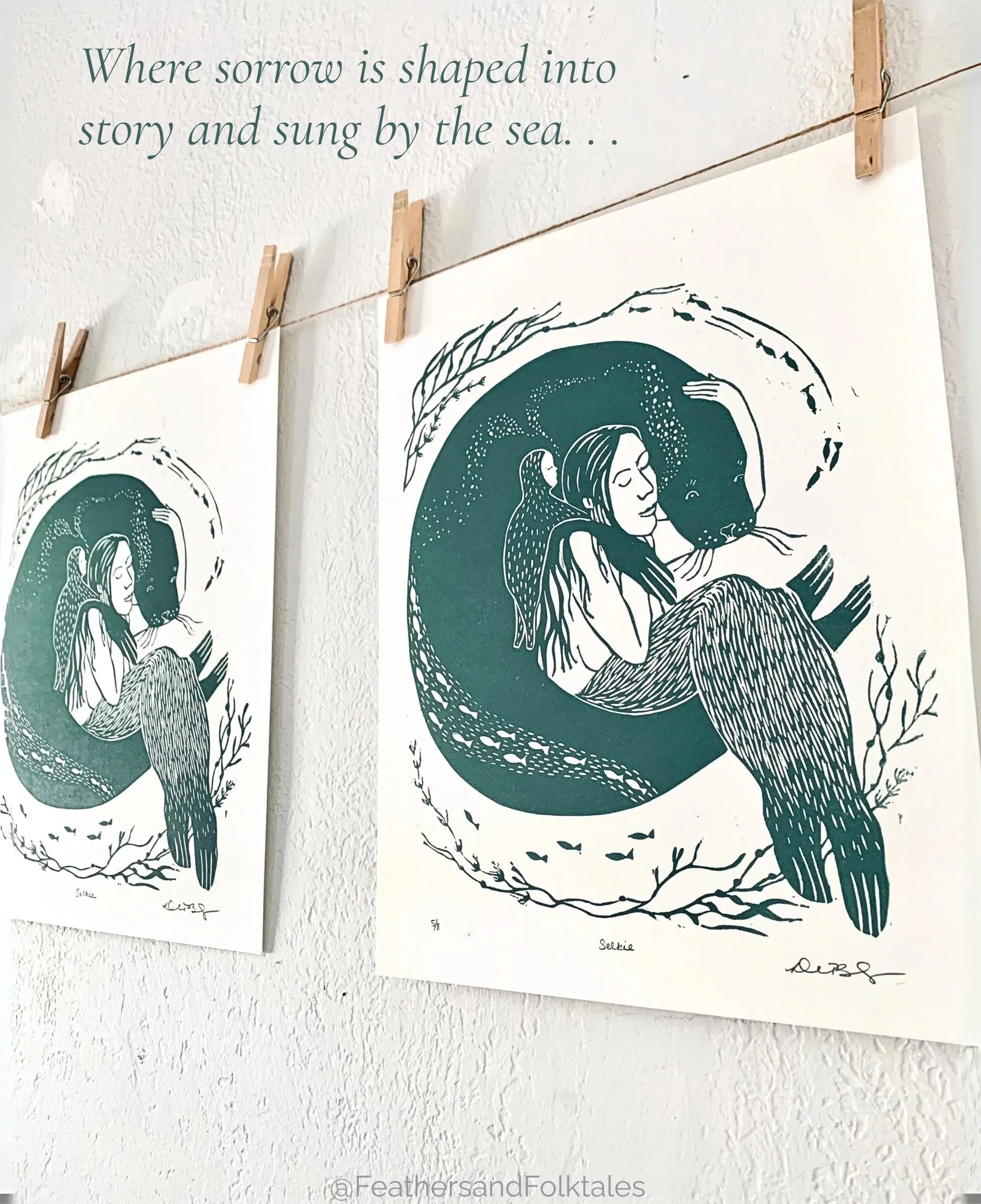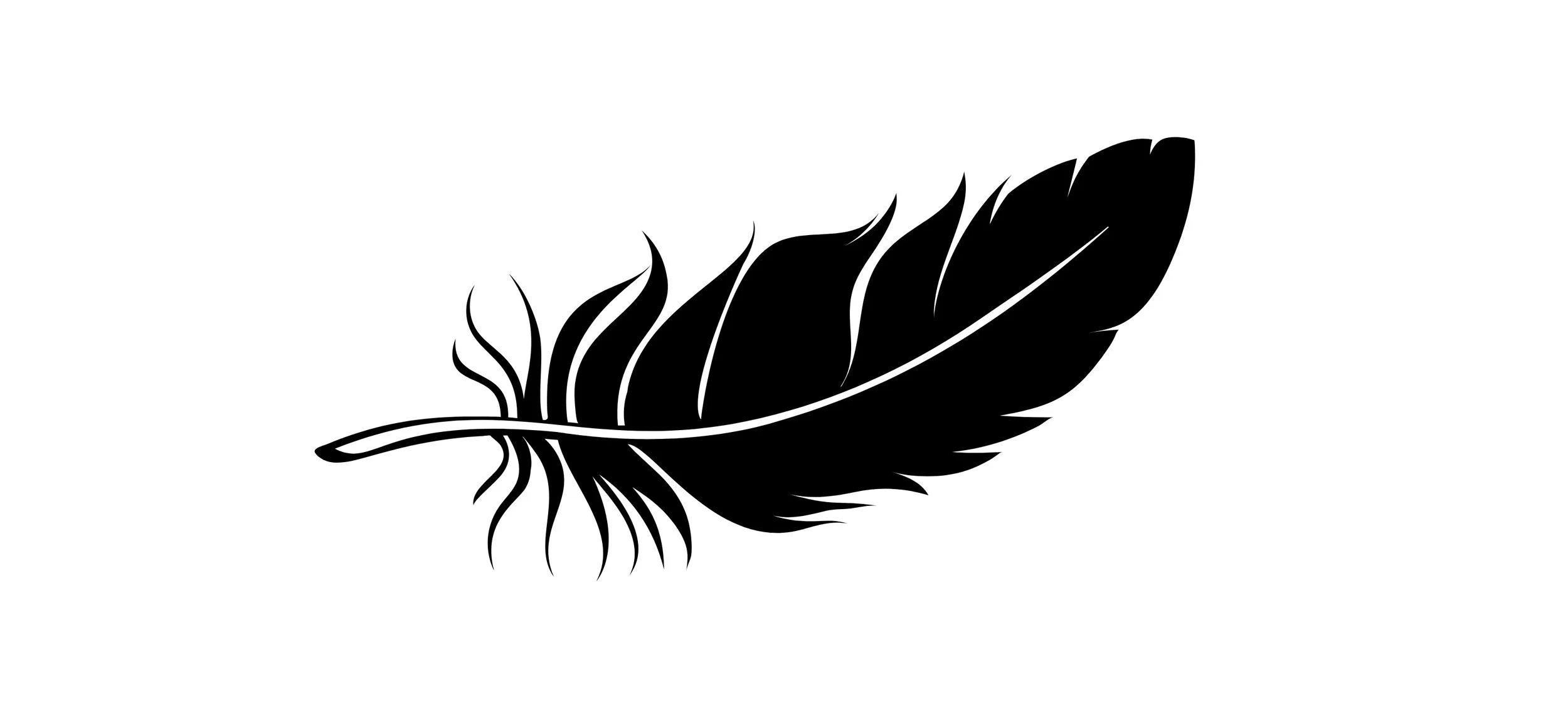A splash of gray flippers, the briny breath of sea kelp, and the fierce pull of tides — this is the heartbeat of the folklore of the Selkie from the wind-lashed coasts of Ireland, Iceland, and Scotland. It speaks of a time and place when myth was a way of making sense of both sorrow and survival, and where sea creatures were endowed with personhood, their souls as real and revered as our own. Selkies were said to slip between worlds — shapeshifters half of the sea, half human — born of brine and breath, reminding those who lived along the ragged coasts that the veil between the human and the wild, the seen and the unseen, was always thinner than it seemed.
Within this ancient folklore, one story rises again and again from the waves . . .A Selkie, a seal-woman of the deep, comes ashore and slips out of her pelt and is seen by a fisherman who does not know how to love without possession. He hides her seal-skin, binding her to a life not her own, a world where her wildness slowly fades into silence.
She becomes a wife and bears a child, yet the villagers call her otherworldly. Something in her gaze remains distant — an undertow of longing too deep for words. Years pass but one day, the hidden pelt is found — not by her, but by her child, whose small hands awaken a buried truth. The moment she touches her skin again, memory returns — not just of the sea, but of herself. Though her love for the child is deep, the pull of the sea is deeper still — ancient, instinctual, undeniable. And so she returns.
Her parting is not betrayal, but remembrance — an act of soul-recovery. She trusts the child, born of land and sea, will one day learn to swim between both worlds. Her absence is carved by grief, echoing with the truth that to reclaim oneself, something must always be left behind. The Selkie gives us permission to do the same: to heed the haunting call, to retrieve what was buried, and to return — fierce, full, and free — to the deep waters of our own becoming.
Though this is a folktale from ancient times, the theme still resonates today. So many of us are like the Selkie, prey to various forms of predators who strip us of our skins. We can become enamored by coercive marriages of all kinds that ask us to trade our wildness for belonging, to hide our skins in order to be loved. We may be lured by choices that do not fit, where the salt leaves our skin and our joy dries quietly beneath duty. Like Selkie, we may unknowingly strive for belonging among those who live only on shore and love only the version of us they can contain — not the vast, tidal self we truly are. This tale is not just about captivity, but about return — the sacred act of remembering, of finding the skin we buried in order to survive and thrive. It is a call to slip back into our true forms, to dive once more into the waters that know our name.
What moves me most is that it is not the grown woman who finds the lost skin — but the child. Or perhaps, more truly, the inner child: the wild, untamed self who still remembers what was buried. It is this younger self — unshaped by expectation, unshackled by survival — who hears the sea’s call clearest, who knows where the soul was hidden. The story whispers reminding us it is the child within us, the one who once danced without reason and followed joy like a tide, who remembers and recovers what was lost. How hauntingly true that this old tale carries a wisdom once known and still true: that to reclaim the soul is to turn inward, to the small, sacred younger self who never forgot the way back to the sea.
Whether we find ourselves in the Selkie, her human lover, their child or all three, within the spell of the telling we may recognize the many selves we carry. We may see the part of us who is lured by false hope, the one who sheds our own skin to find love and belonging, only to awaken stranded on a shore not our own. We may remember the child within — tender and instinctual — who senses the truth buried beneath duty, and dares to dig where the soul was once hidden. We may remember the ocean-mother inside us, that untamed guide, the ancestral memory that calls us home and births us into healing. To journey through this myth is to witness the whole of us: the one who leaves; the one who betrays herself for safety, love and belonging; and the one who remembers. Who among us sees the whole — the wild, the wounded, the wonder within? In a world that worships the shore-bound and the tamed there are no medals for wild soul-tending. The quiet work of feral becoming is rarely honored because our predatory world often fears a prey it cannot tame. Yet to retain one’s wild nature against the pressure to fit in is the truest kind of magic. I love Dr. Clarissa Pinkola Este’s version of the Selkie story in her book Women Who Run With the Wolves. She says, "Within every woman there is a wild and natural creature, a powerful force, filled with good instincts, passionate creativity, and ageless knowing. Her name is Wild Woman, but she is an endangered species”. Indeed, the work of wild becoming is vital conservation work, a labor of love we must tend to save the endangered species, the wild woman within.
The folktale of the Selkie combines the bitter and the sweet - a hauntingly relevant message for modern souls. Selkie’s choice to leave her child to return to the sea can sometimes feel too heartbreaking or hard to grasp. In this light, the story speaks to the tension at play between the loss the mother bears to raise the child, and the loss the child bears to let his mother go revealing the true cost of reclaiming oneself. This is the grief left in the wake of a predator’s theft: when choice is never part of the story, the losses compound, and something sacred must be sacrificed to restore the balance that never should have been broken to begin with.
But, as the old stories know, grief and self-honoring do not erase one another; they move in tandem, like tide and moon, revealing the quiet beauty within the ache of becoming. Certainly, we have all experienced a Selkie choice at one point or other in our lives. It reminds me of the Mary Oliver poem We Shake With Joy:
“We shake with joy, we shake with grief.
What a time they have, these two
Housed as they are in the same body”.
Like these contrasting emotions both housed in one body, the story unfolds too along the boundary where land and sea touch and intermingle —a threshold between worlds. In fairytales, folktales and myth, often these liminal places are magical sites of transformation. Just as scientists call such places ecotones, rich with life born from the meeting of worlds, stories like the Selkie reveal that the in-between is both a place of loss, and of becoming—where something new and vital is born. In the resonating words of Rebecca Solnit, author of Hope in the Dark: Untold Histories, Wild Possibilities, brokenness and beauty can sometimes intertwine, and both Solnit and the Selkie folktale suggest that there is a crucial need to embrace, “complexities and uncertainties, with openings”. Finding one’s true self is about integrating all the inevitable pains, defects, woundings into one’s authentic story and this is the gift this folktale offers us, in spotted gray flippers, whiskers and a magical underwater world.
The folklore of the Selkie stirs a tide-old memory that we are seal-daughters and driftwood sons, once bound to shore by hands that did not know our name. Especially during these divisive times, how can we carry the memory of the wild depths of our oceanic home while the surface seas of the world churn with division? Keeping one’s skin can mean guarding the pelt of one’s sovereign spirit, resisting the spell of forgetting woven by the coercive marriages of belonging — those false unions that would have us wed our worth to sides instead of souls. Selkie is a reminder that we are not strangers to the sea, but our salty sweat and tears reveal we are always wrapped in the cloak of her tides, enveloped in the embrace of her brine hide.
Blog Post Cover Credit: Wendy Wei on Pexels
References:
Pinkola-Estes, Clarissa (1996). Women Who Run With the Wolves: Myths and Stories of the Wild Woman Archetype. Ballantine Books.
Solnit, Rebecca (2016). Hope in the Dark: Untold Histories, Wild Possibilities. Haymarket Books











Many maritime myths are stories of love and loss, where the ocean is not just a backdrop but a character in her own right. Like a great mother who bears witness to sorrow, her saltwater depths cradle and honor the tears that fall. Just as salt has long been used as a healing salve, the sea itself becomes a balm—ritualizing grief and softening it into something the heart can hold, both for those who live the tale and those who witness it.